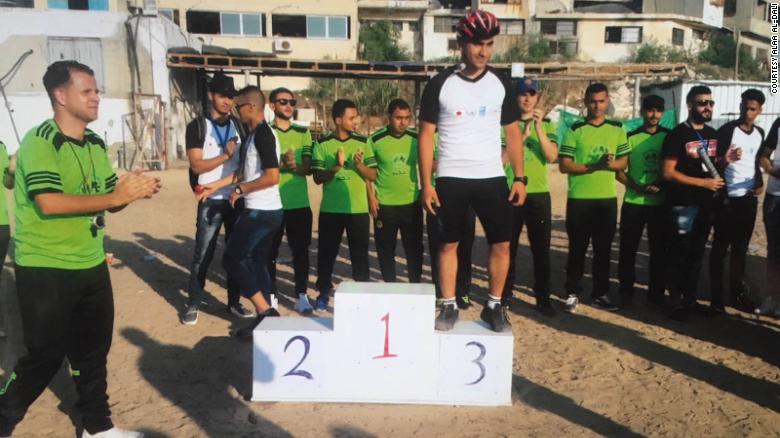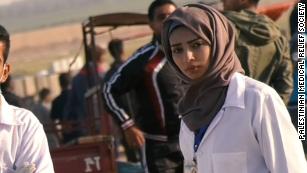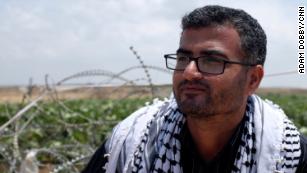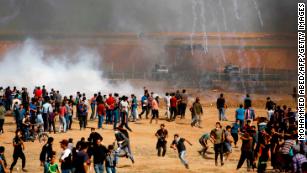“Fifty percent of those who were wounded will never walk naturally again. Not after a year or two or three or 10 years.”
Hundreds in months-long Gaza protests crippled for life by Israeli gunfire
By Ben Wedeman, CNN
Updated 1706 GMT (0106 HKT) June 8, 2018
Gaza cyclist has leg amputed after being shot 06:21
Gaza (CNN) A bloody scalpel in his hand, the surgeon pauses over the gaping wound in his patient’s right leg.
“The entry point is very small,” explains Dr. Bassam Harasha. “But inside the tissue this type of bullet is doing explosion, and this explosive effect of this bullet is doing massive destruction in the tissue and the bone so most of the patients, they underwent amputation. We have no chance to save the limb like other bullet injuries, traditional bullet injuries outside this area.”
He goes back to scraping off scraps of bloody flesh. Harasha has come from Jordan as a volunteer to Gaza City’s Al-Shifa Hospital. And he’s very busy.
His patient, Hashim Amr, a man in his 40s with a gray beard, is wide awake. The anesthetics have only numbed his lower body. As doctors labor away, he recounts that during the 2014 war, his 17-year-old son was killed in an Israeli missile strike.
Dina Nasser, a veteran nurse from Jerusalem’s Victoria-Augusta Hospital, emerges from the adjacent operating theatre. Of the patients she has seen, she says, “Their bones are fractured into splinters. There’s lots of muscle damage and tendon ruptures. There are images of the bone basically having a hole in it.”
According to the Palestinian Health Ministry in Gaza, more than, 3,600 people have suffered gunshot wounds, nearly 60% to the lower limbs, during the weekly protests known as the Great Marches of Return along the fence that separates Gaza from Israel. Israeli gunfire has killed more than 120 people, including children, health workers and journalists. But it’s not just the high casualty figures that have drawn attention. It’s the nature of the wounds.
Speaking at a recent news conference in Gaza, Commissioner General of the UN Relief and Works Agency for Palestine Refugees Pierre Krähenbühl said, “I was also struck not only by the number of injured but also by the nature of the injuries. The demonstrators had been systematically shot either in the lower limbs (shattering femurs, knees and ankles), in the abdomen, the back or the head. The pattern of small entry wounds and large exit wounds indicates ammunition used caused severe damage to internal organs, muscle tissue and bones.”
At the Indonesian Hospital in Bait Lahiya in northern Gaza, the outpatient clinic teams with young men on crutches wait to be seen by doctors. Many of their wounds appear to be from 7.62-millimeter sniper rounds fired by Israeli forces. Sniper rifles have a range that can exceed 800 meters, so when fired over a shorter distance — up to, say, a couple of hundred meters — the effect can be devastating on the human body.
Dr. Bassam Al-Masri has tended to the wounded from the Second Intifada, plus the Gaza wars of 2008, 2012 and 2014.
“The bullet itself is different from before,” he says. “We used to find intact bullets. Now we don’t. We just find shrapnel.”
Nodding to those waiting to see him, he adds, “Fifty percent of those who were wounded will never walk naturally again. Not after a year or two or three or 10 years.”
Israeli Army spokesman Lt. Colonel Jonathan Conricus insists their tactics are intended to minimize fatalities.
“Each sniper fires only at orders of commanders,” he tells CNN. “The snipers fire at the feet or the legs of the assailants who try to penetrate into Israel using only standard ammunition, which are according to international law and used by other militaries as well.”
Israeli officials say the protesters threw Molotov cocktails and stones at Israeli soldiers positioned along the fence. No Israeli soldiers were killed or injured during the protests.
Prominent Israeli human rights lawyer Michael Sfard believes the Israeli army could have avoided the use of lethal force.
“There are people among the protesters who wanted to get to the fence, who wanted to damage the fence, who wanted to cross the fence, who maybe even wanted to cross the fence in order to do bad things,” says Sfard.
“The IDF is the strongest army in the Middle East. It has loads of tools. It can apprehend those people, it can put them to trial and even incarcerate them to long prison terms. It can use tear gas. It can use water guns. It can do so many things,” he adds.
The Israeli government accuses Hamas, which controls Gaza, of using the protesters as pawns to penetrate the fence and attempt to return to their homes of more than half a century ago. Prime Minister Benjamin Netanyahu defended the army’s actions, saying no country would allow threats to its sovereignty.
Still, the IDF claims it used restraint.
“The IDF has been defending Israeli communities and Israeli civilians against multiple attacks from Gaza towards Israel over the last two months. Throughout these attacks, we have been using different measures — riot control measures, and as a last resort, we have used sniper fire in order to stop the most dangerous of threats from breeching the border and coming into Israel,” says Conricus.
“I’d like to emphasize that we have only been using standard ammunition only, not special, nothing out of the ordinary, standard sniper ammunition only,” he adds.
Ghassan Abu-Sitta runs the American University of Beirut (AUB) Hospital’s reconstructive surgery, and has been coming to Gaza since the 1980s.
“It is these almost identical cases of complex injuries to the limbs needing protracted and repeated surgical interventions, surgical interventions, and really complex surgical interventions because of the amount of tissue destruction that these high velocity bullets produce,” said Abu-Sitta.
What’s not in dispute is that Israeli forces have wounded thousands of Palestinians, many now handicapped for life.
Among the injured is 20-year-old Alaa Al-Dali from Rafah, near the border with Egypt. He was shot during the first of the Great March of Return protests on March 30.
He is propped up on his bed in a simple bedroom. In the corner on a dresser hangs his helmet and cycling medals, dangling above a collection of trophies. On a simple white cupboard, someone has scrawled images of Disney characters.
“I went by bike, in my cycling shoes and uniform, to the protest,” he said. “I thought my chances of being shot were one in a hundred. If I had known a single hair on my head would have been harmed I wouldn’t have gone.”

Alaa Al-Dali (C) qualified to be part of the Palestinian cycling team for Asia games. Then he lost his leg during a protest.
Chance was not on his side. Shortly after he arrived at the protest site near Rafah, a bullet ripped into Alaa’s right leg, even though he insists he was well away from the fence separating Gaza and Israel.
“When the doctor saw me, the first thing he said was, ‘We’ll have to amputate.’ I was shocked. I begged him not to amputate. I thought I was dreaming, having a nightmare and I wanted to wake up from it.”
After several operations, surgeons amputated his right leg above the knee.
Alaa had qualified to be part of the Palestinian cycling team at the upcoming Asian games in Indonesia this summer. Now his bicycle sits idle outside his bedroom, leaning against his new wheelchair.
“The dream I’ve been pursuing and training for, for years, disappeared in the blink of an eye,” Alaa says.
His father, Lutfi, tells CNN he once made a good living running a furniture workshop in Israel. It’s been years since he has had steady work. Like many in Gaza who came of age before the signing of the Oslo Peace Accords in 1993, he is contemptuous of all Palestinian factions, under whom life has gone from bad to worse to worse still. Hamas, which has ruled Gaza since 2007, says Lutfi, “eats cake, while we search for bread.”
Lutfi says he has no idea how he will be able to support his now-handicapped son.
AUB Hospital’s Dr. Abu-Sitta sees the epidemic of bullet wounds as the start of decades of disability for a generation of young Palestinians.
“If you permanently cripple that individual,” he says, “not only are you taking away their ability to contribute economically, they become an economic burden. If they are in their 20s or late teens, then that’s a lifetime of economic disability. They need help.”






Geen opmerkingen:
Een reactie posten